CHAPTER 2
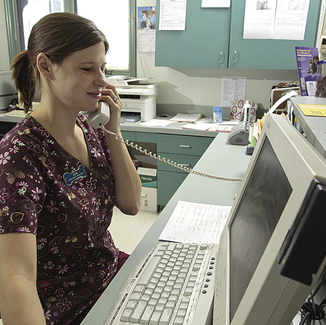
The Receptionist Team
Mastery of the content in this chapter will enable the reader to:
• Develop effective phone techniques.
• Develop frequently asked questions for the reception team.
• Describe how to control telephone conversations with clients.
• Identify techniques for handling multiple phone lines.
• Identify techniques used to turn a phone “shopper” into an appointment.
• Define the liability associated with giving medical advice over the phone.
• Describe methods to greet clients effectively.
• Differentiate forms used in the veterinary practice.
• Identify a veterinary health certificate.
• Effectively discuss invoices with clients.
• List methods to accept payments on client accounts.
• Handle declined credit card transactions comfortably.
• Explain how to reconcile the end-of-day transactions and totals.
The ultimate goal of the receptionist team is to provide immediate, consistent, dependable, and courteous service to the client. The receptionist is the front line of any veterinary health care team. This person is responsible for clients’ first impressions and should therefore greet them in a friendly manner when they call the practice or walk in the door. Receptionists offer helpful information and explain any charges for which the client is responsible. They are also the last member of the team to take care of clients; therefore the need to make a lasting positive impression is a must. Receptionists should have a professional demeanor and appearance. They monitor the reception area for any dirt or hair pets leave behind. The reception area should project a clean, warm atmosphere (Figure 2-1).
TEAM ETIQUETTE
Actions of team members are observed by clients, patients, visitors, and fellow employees. The potential for veterinary practice growth, client acceptance, and compliance is based on team member etiquette. The failure to use etiquette among team members can be detrimental. Clients perceive the stress associated with poor etiquette, ultimately leading to decreased communication, client noncompliance, and poor profits (Box 2-1).
DEVELOPING EFFECTIVE PHONE TECHNIQUES
The tone of a voice is also referred to as pitch. Some speakers have a low, comforting tone, which increases the quality of the conversation. Others may have a high, squeaky pitch. Some clients may be unable to understand a squeaky voice and become irritated. The tone of voice a receptionist uses to answer the phone can give a client a lasting impression. Team members should have a pleasant, confident, and understandable voice. Tones can indicate “I am too busy to take your call right now” or “I am at your service today; how may I help you?” Team members should smile as they answer the phone; the tone of that smile will come across the phone line (Figure 2-2).
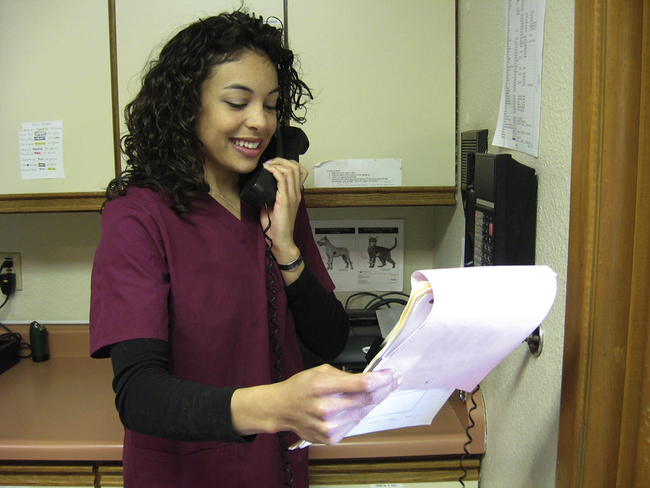
• Clients wanting to talk with the veterinarian immediately
• Clients asking for an update on a hospitalized pet
• A client asking questions regarding a statement or invoice
• Refill requests for food and medications
Role playing can facilitate correct responses to these potentially difficult situations.
Team members must learn not to say certain phrases. Expressions such as “I don’t know” can imply the team member is not knowledgeable or does not care to get the correct information for the client. Instead of saying “I don’t know,” team members should reply, “that is a great question, let me find out.” Rather than saying a hurried “just a second,” a team member might say “give me just a moment to get that [information or product].” The combination of words and tone can have a powerful effect on clients. Words and phrases such as “absolutely!”, “I know how much you care,” and “I understand” are powerful in creating empathy with clients (Box 2-2).
Some clients enjoy casual phone conversations with the staff. Clients enjoy talking about their pets, and veterinary professionals are ideal listeners. However, the receptionist must control the conversation. Team members want to let clients know they are listening, caring, and compassionate, but another phone line may be ringing or another client may be waiting to pick up a pet (Figure 2-3). A few options exist to help control this conversation. It is acceptable to let the client know that there is another client waiting and that someone will call the client back with more information in approximately 10 minutes (then follow the general rule and call back in 5 minutes). Otherwise, ask closed-ended (yes or no) questions only, such as “Is Fluffy vomiting?” or “Does Fluffy have diarrhea?” Some clients may still attempt to prolong the conversation, but team members usually can get an appointment scheduled and end the conversation. It can be difficult to end a conversation without making the client perceive that the team member does not care. However, with practice and role playing team members can learn to convey sincerity.
• How old do puppies and kittens have to be to start vaccinations?
• What vaccinations are recommended?
• What vaccinations are included?
• How often are vaccinations given?
• What is included in the initial puppy or kitten examination?
• How old do pets have to be to be altered?
• Do vaccinations have to be current?
• What does the surgical procedure entail?
• Is pain medication included?
• When do pets need to arrive at the practice?
• When are they usually ready to go home?
• Do they need to be held off food and water?
• How much does the procedure cost?
• Is the pet vomiting? If yes, for how long?
• Does the pet have diarrhea? If yes, for how long?
• Does the pet have an appetite?
• What tests are required to start the pet on preventive?
• What products does the practice carry?
• How often is it administered?
• What diseases are carried by fleas and ticks?
• Can people catch these diseases?
• What products does the practice carry?
• How are these products administered?
• How often are these products administered?
MANAGING MULTIPLE PHONE LINES
Many practices have multiple phone lines to answer, clients to greet as they walk in and out of the practice, and invoices or charges to enter (Figure 2-4). As a general rule, phones should not ring more than three times before being answered. If a receptionist is with another client or on another line, it is acceptable to ask the client to hold momentarily because another phone line is ringing. For example, “Good morning, ABC Animal Clinic, this is Teresa. I am on the other line [or with another client], are you able to hold one moment?” Once the client answers yes, the team member should say thank you. This allows the receptionist to finish with the first client. Asking a client “Are you able to hold one moment?” does exactly that; it asks the client politely. A short “can you hold?” becomes a demand rather than a question. “Thank you for holding, how may I help you?” can then resume the conversation. If multiple lines continue ringing, a receptionist may also ask clients if a return call is possible instead of waiting on hold. “Thank you for holding, this is Teresa. I have a client waiting for me, do you mind if I call you back in 10 minutes so you do not have to continue to hold?” Once again, the client should be called back within 5 minutes.
The time a client is on hold can be a valuable marketing resource time. Special on-hold systems can generate specific messages about the veterinary practice or specific diseases that may be a concern to the area. Clients can be educated on a variety of topics while they are on hold. This information can include practice hours, history of the veterinarians, or specialties or products that the practice offers. (See Chapter 10 for more information regarding marketing for the veterinary practice.) If the caller has something to listen to, the wait time does not seem as long. Recordings can also assure the client that the phone line has not been disconnected. It can be difficult to determine if a call has been disconnected if the line is silent.
An ideal scenario is to have a call center located separately from the reception area (Figure 2-5). This allows the receptionist to give clients full attention as they enter and leave the practice. Mistakes are decreased when team members can concentrate on one client at a time. The call center can concentrate on answering calls promptly and can review patient histories without other clients overhearing conversations. Some practice owners may argue that this will increase labor costs; however, if a receptionist can increase an average transaction by $10 either by catching a missed charge or by selling a client an extra $10 of service, then one receptionist has covered the cost of the labor and increased the profits at the end of the day (Box 2-3). Ultimately, clients are satisfied and will return because they experienced superior customer service within the veterinary practice.
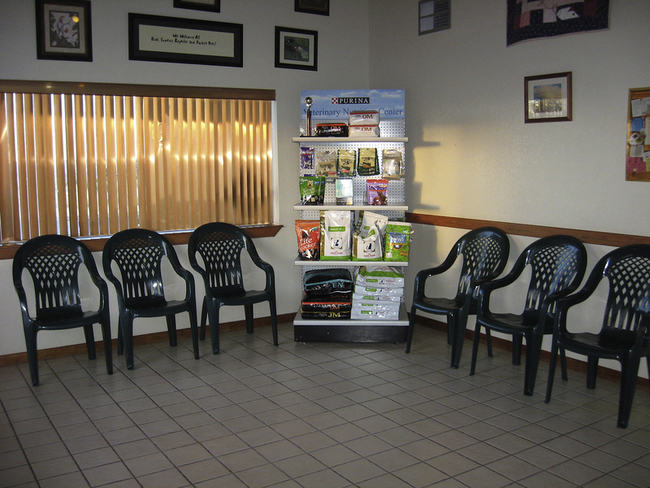
 PRACTICE POINT
PRACTICE POINT PRACTICE POINT
PRACTICE POINT PRACTICE POINT
PRACTICE POINT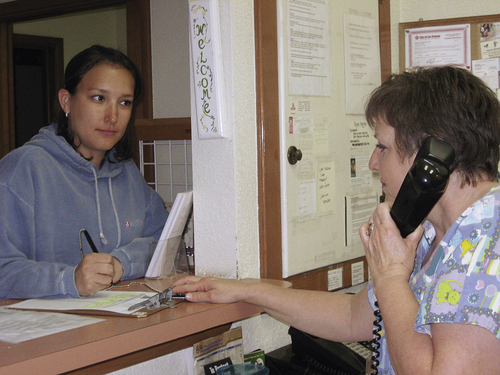
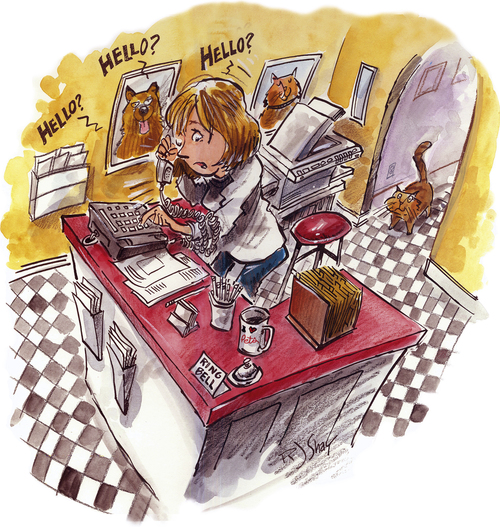
 PRACTICE POINT
PRACTICE POINT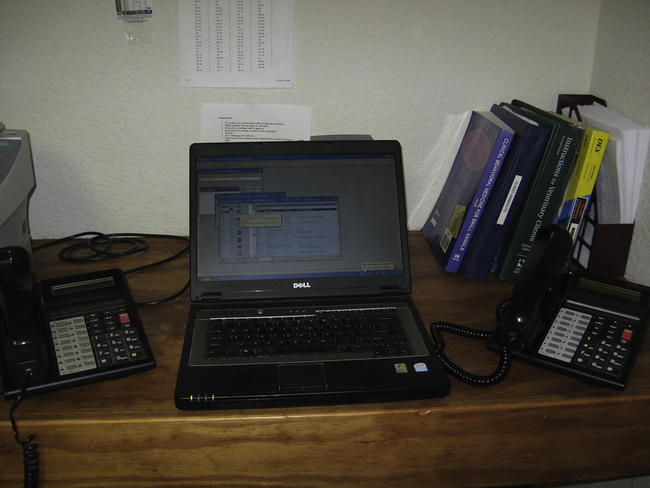
 PRACTICE POINT
PRACTICE POINT PRACTICE POINT
PRACTICE POINT


